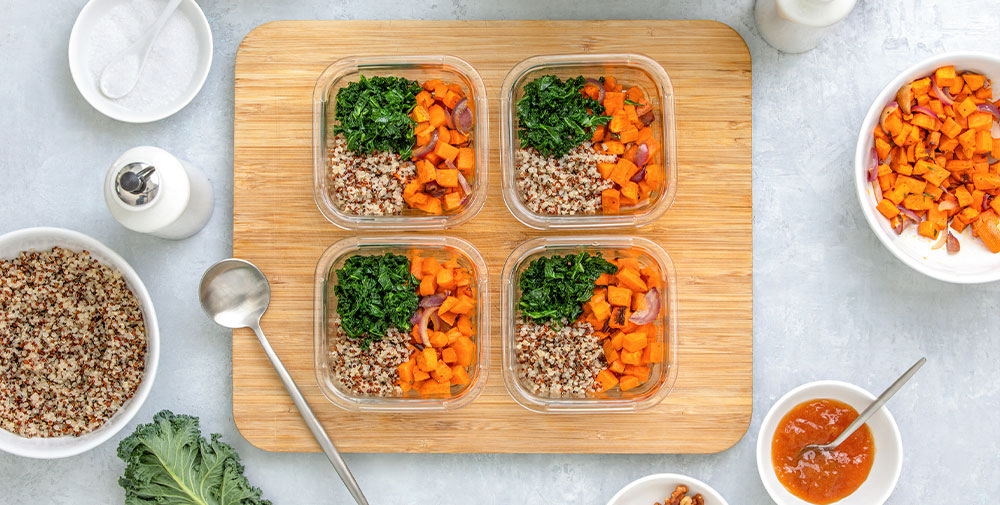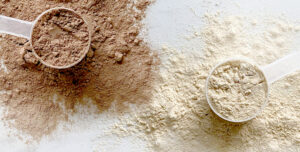Maintaining a calorie deficit, or consuming fewer calories than you burn, is the key to weight loss.
A study, which was designed to compare the effects of two different weight loss methods – a diet alone versus a diet combined with aerobic training – showed that “independently of the method for weight loss, the negative energy balance alone is responsible for weight reduction.”
Since most people can lower their calorie intake to a greater degree than they can burn calories through exercise, cutting calories appears to promote weight loss more effectively than only increasing exercise.
That said, cutting calories through your diet and burning calories through exercise is an effective way to achieve your weight loss goals. In fact, studies have shown that people who lose weight and keep it off in the long run typically get regular physical activity. That’s because regular physical activity can help you maintain your weight loss as opposed to “crash dieting,” or drastically restricting your daily calories, which can lead to regaining weight quickly – often as soon as six months after you stop dieting.
Calories In vs. Calories Out
Metabolism is the process by which your body converts what you eat and drink into energy. Several factors determine your individual basal metabolism, including your age, sex, height, weight, body composition, and physical activity levels.
Calories “in” are the units of energy that you get from the food and beverages that you consume, while calories “out” consist largely of resting energy expenditure (REE).
Resting energy expenditure, or basal metabolism of your body ‘at rest,’ refers to the calories your body uses for functions that keep you alive, such as breathing, circulating blood, adjusting hormone levels, and growing and repairing cells. Resting energy expenditure accounts for 60% to 70% of your total daily energy expenditure.
In addition to your basal metabolic rate (BMR), physical activity and thermic effect of food (TEF), which refers to the amount of energy it takes for your body to digest, absorb, and metabolize the food that you eat, are the other two components of total energy expenditure.
How To Calculate Your Daily Calorie Goal For A Calorie Deficit Meal Plan
Your body needs a certain number of calories each day in order to perform all of its daily functions. Calorie needs for adult women range from 1,600 to 2,200 calories per day, while estimates for adult men range from 2,000 to 3,200 calories each day.
As a general rule of thumb, the low end of the range is typically more appropriate for people who get very little to no physical activity throughout the day, while the high end of the range may be better suited for people who are very active.
For most healthy adults, a calorie deficit of around 500 calories per day is sufficient for weight loss. A 500-calorie deficit is also unlikely to significantly affect your hunger or energy levels.
However, before you can create a calorie deficit, you first need to know what your maintenance calories, or the number of calories your body needs to support energy expenditure, are. So, let’s calculate the number of calories that you need in order to maintain your current weight.
How To Calculate The Number Of Calories You Need To Maintain Your Current Weight
If you’re moderately active – you get at least 30 minutes of physical activity in a day in the form of exercise, such as walking at a brisk pace, climbing stairs, or doing outdoor activities like gardening – you can multiply your current weight by 15, which is roughly the number of calories per pound of body weight needed to maintain your current weight if you’re moderately active.
Once you know the number of calories per day that you need in order to maintain your current weight, you can then consume roughly 500 calories less than your weight-maintenance amount for a healthful calorie deficit.
Why 500 calories? Well, in order to lose one pound per week, research indicates your food consumption should provide roughly 500 calories less than your total weight-maintenance calories. And since diet and exercise go hand in hand when it comes to weight loss, in addition to reducing your daily calorie intake by roughly 500 calories, you should also try to do at least 30 minutes of physical activity on most days in order to be able to lose at least a pound per week.
To ensure healthy weight loss and adequate nutrient intake, women should not consume fewer than 1,200 calories per day and men shouldn’t consume fewer than 1,500 calories per day because eating too few calories can endanger your health by depriving you of critical nutrients that you need to survive.
Calorie Calculators
If math isn’t your strong suit, don’t worry! You can also use a calorie calculator to estimate the number of calories you need to consume each day for weight-maintenance. Plus, some calorie calculators can give you guidance for gaining or losing weight.
Creating A Calorie Deficit Meal Plan For Weight Loss
When done correctly, meal planning can help you create the calorie deficit that you need for weight loss, while also providing your body with all of the nutrient-rich foods that it needs to function and remain healthy.
In fact, one study concluded that “individuals planning their meals were more likely to have a better dietary quality, including a higher adherence with nutritional guidelines, as well as an increased food variety. Additionally, meal planning was associated with lower odds of being obese in men and women and overweight in women only.”
So, if your goal is to lose weight or maintain health, it’s important to eat nutrient dense foods. A healthful eating pattern with fewer calories should include:
- Vegetables: Dark green, red, and orange vegetables, such as spinach, kale, broccoli, Brussels sprouts, bell peppers, tomatoes, cabbage, and carrots, as well as starchy vegetables like sweet potatoes, peas, beans, butternut squash, lentils, and chickpeas.
- Whole Grains and Enriched Refined Grains: Whole oats, whole wheat, whole-grain breads, whole-grain pastas, barley, brown rice, quinoa, corn, and popcorn.
- Fruits: Grapefruit, apples, blueberries, strawberries, oranges, bananas, kiwi, and avocados.
- Protein: Lean meats such as lean beef or chicken, eggs, unsalted nuts, soy products, and seafood.
- Low-Fat or Fat-Free Dairy: Greek yogurt, milk, and low- or nonfat cheese.
- Healthful Oils: Olive oil, canola oil, and coconut oil.
As you can see, a good weight loss meal plan should include lots of protein and fiber-rich foods, as well as a variety of fruits and vegetables, in order to contribute to feelings of fullness. It’s also important to limit processed foods and added sugar, which make it difficult to lose weight or meet your nutrient needs.
To build nutrient-dense meals, try to fill one-third to one-half of your plate with non-starchy vegetables, one-quarter to one-third of your plate with protein-rich foods, and the remainder of your plate with whole grains, fruit, or starchy vegetables. You can also enhance the flavor of your foods by using a small amount of healthy fats from foods like avocados, olives, or nuts.
7 Tips For Meal Planning Success
1. Write Out Your Grocery Shopping List In Advance
Take 20 to 30 minutes each week to plan your meals and create your supermarket shopping list. Bringing a shopping list with you to the supermarket will not only help you save time in the store, it will also help you stick to your list and avoid buying junk food that may tempt you in the store. Also, never shop hungry!
2. Avoid Certain Foods And Beverages
Dietary guidelines recommend avoiding foods with added sugar, fat, or salt. So, if you know that restrictive diets are difficult for you to follow, instead try to limit your intake of added sugar and/or saturated fats to less than 10% of your daily calories. Also, try to consume less than 2,300 milligrams of sodium per day.
And by eliminating (or reducing) your intake of sugary beverages such as soda, fruit juices, and specialty coffee drinks, you may be able to eliminate several hundred calories from your diet. In fact, replacing all sugar-sweetened beverages with water may even lead to a 2% loss of body weight over six months.
3. Prep Foods In Advance
To help you stick to your diet plan, organize your meals in advance. For instance, after you eat dinner, you can lay out the foods that you’ll eat the next day for breakfast and lunch. You can also prepare any other small meals that you plan on eating the following day, too. And depending upon how much free time you have in the evening, you may also choose to meal prep for your next night’s healthy dinner.
4. Consider Using A Meal Planning App
Since meal planning is one of the best ways to stay on top of your weight loss goals, consider using a meal planning app that offers meal plan templates that you can adjust based on your food preferences or allergies.
Meal planning apps can also help you keep track of your favorite recipes, provide customized grocery lists based on your selected recipes (or what’s leftover in your refrigerator), and help you save time!
5. Be Mindful Of Your Meal Timing And Frequency
Research suggests that a healthful meal pattern should include breakfast, two or three meals a day, regular fasting periods, and consuming a higher proportion of your calories earlier in the day.
By eating small meals throughout the day, it can help promote feelings of fullness and reduce the overall number of calories that you eat per day. Some benefits of this meal pattern may include reduced inflammation, stress resistance, and better sleep quality.
6. Continue Eating Primarily Home-Cooked Meals
If you’re new to meal planning, it may seem time-consuming and overwhelming at first. However, once you have a meal planning system in place, it will take you less and less time to come up with your weight loss meal plan for the week.
So, stick with it and continue preparing and eating primarily home-cooked meals. That’s because preparing and eating your meals at home allows you to control the ingredients and the portion sizes that you serve.
One study even found that people who cooked dinner at home six to seven times per week consumed almost 140 fewer calories per day, on average, than people who cooked dinner at home once per week, or not at all.
7. Make Sure That You’re Consuming Enough Calories
Since your body requires a minimum number of calories to function properly, cutting too many calories can increase the risk of health issues, including not getting enough nutrients, which can interfere with gaining or maintaining bone mass, depriving the brain of necessary energy, decreasing metabolism, and increasing the risk of developing gallstones.
Some symptoms of not consuming enough calories are getting sick frequently, being unable to lose weight, experiencing negative changes in mood or behavior, having difficulty sleeping, and experiencing constipation.
3 Easy Recipes For Weight Loss
To prove that weight loss recipes can be easy to make, here are three simple weight loss recipe ideas that don’t require a lot of ingredients (or cook time)!
Salads: To make quick and versatile salads, all you need are leafy greens, a few colorful vegetables, and a source of protein. Top your salad with olive oil and vinegar, and then enjoy! Feel free to add nuts, whole grains, or starchy vegetables if you’d like, too.
Grain Bowls: First, batch cook grains like quinoa or brown rice. Then top your grain bowls with a protein (like chicken or hard-boiled eggs), non-starchy veggies, and a healthy dressing.
Homemade Pizza: Arguably one of the most popular foods in the world (that even picky eaters love), start your pizza with a veggie or whole-grain based crust, a thin layer of sauce, a source of protein, and veggies. Top with a little cheese and fresh leafy greens and you have a guilt-free pizza recipe that you can come back to whenever you’re in the mood.







